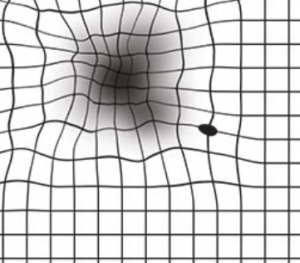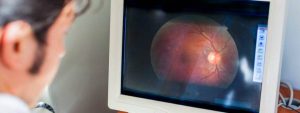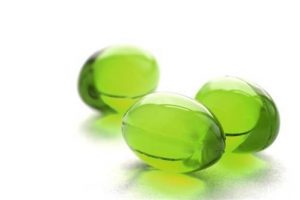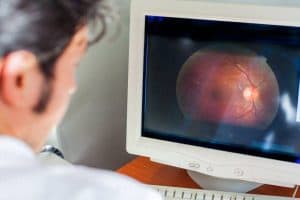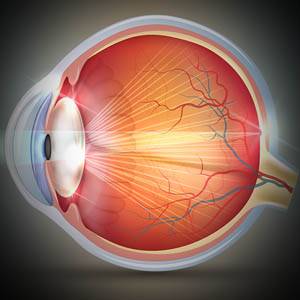Dry AMD accounts for 80-90 percent of all AMD cases.
Macular degeneration, also known as age-related macular degeneration (AMD), is an eye disease that occurs as a result of permanent damage to the macula, the center of the retina.
Dry AMD causes loss of central vision and the ability to see fine details.
Dry AMD is the most common form of AMD. It progresses slowly over many years, sometimes even decades, and is therefore considered the less aggressive form of AMD.
The disease may first develop in one eye, though it commonly affects both eyes.
Dry AMD significantly impacts reading, driving, using a computer, watching TV, seeing the hands on a clock, facial recognition, and many other regular activities.
- Macular degeneration accounts for 8.7% of global blindness.
- Dry AMD is one of the leading causes of vision loss in adults over the age of 50.
What causes dry AMD?
Dry AMD can be caused by thinning of the macula that occurs with aging, pigment in the macula, or a combination of the two— resulting in diminished vision clarity over time.
Scientists continue to search for the underlying cause of dry AMD. However, current research shows that the disease may be linked to heredity and environmental factors such as diet and smoking tobacco.
What are the symptoms of AMD?
Dry AMD usually develops slowly, without any pain, and may go unnoticed— especially if one eye is affected.
Signs and symptoms of dry AMD may include:
- Blurry vision
- Cloudy vision
- Dark ‘blind’ spots in central vision
- Reduced central vision
- Visual distortions, straight lines appear wavy
- Difficulty recognizing faces
- Difficulty adapting to dimly lit rooms
- Requiring brighter lighting for reading
- Colors appear less vibrant
Dry AMD only affects central vision, and vision for fine details. It does not affect peripheral vision— so total blindness is rare.
How is dry AMD diagnosed?
It is crucial for AMD to be diagnosed and treated in its early stages to prevent its advancement to the wet form, which causes sudden and severe vision loss.
Dry AMD is diagnosed during an eye exam through a series of diagnostic tests. Your eye doctor will look for signs of damage to the retina and macula in the back of your eye.
- Retinal exam. After dilating your eyes with special eye drops, your eye doctor will carefully examine your retina, looking for signs of fluid, blood or drusen— yellow deposits that form under the retina.
- Test for central vision. An Amsler grid will help your eye doctor to identify any anomalies in your central vision. If you have AMD, the straight lines in the grid may appear faded, broken or distorted.
- Fluorescein angiography. During this test, a colored dye is injected into a vein in your arm. The dye travels to your retina and highlights any damage to the blood vessels. A special camera then takes pictures as the dye travels through the blood vessels to facilitate identification of damage or fluid leakage.
- Indocyanine green angiography. This test also uses a dye to highlight blood vessel damage, and may be used to confirm the results of a fluorescein angiography or to detect abnormal blood vessels in the deeper layers of the retina.
- Optical coherence tomography (OCT scan). This imaging test creates a detailed image of the cross sections of the retina, and enables your eye doctor to detect any areas that are thinning, thickening or swelling.
If you suspect you have macular degeneration, contact an eye doctor near you, who can diagnose and treat the condition.
SEE RELATED: Amsler Grid Test: Screening for AMD
How is dry AMD treated?
Unfortunately, a cure for AMD is still unknown. However, there are specific treatments used for dry AMD that aim to slow down the progression of the disease.
Treatment of dry AMD generally involves high doses of zinc and antioxidants. Currently the AREDS and AREDS2 formulas are the only effective treatments for intermediate-to-severe dry AMD.
An age-related eye disease study (AREDS) was conducted to determine the most optimal treatment method for dry AMD. According to the study, consumption of high doses of antioxidants and zinc, may reduce AMD progression for those who have intermediate AMD, and those with advanced AMD already in only one eye.
A follow up study known as AREDS2, importantly concluded that lutein and zeaxanthin are highly effective in preserving retinal health.
According to the results of AREDS2, lutein and zeaxanthin reduced dry AMD progression by 19 percent, and vision loss by 25 percent.
While numerous “eye vitamins” and “ocular supplements” are available on the market, it is important to ensure that the formula of these supplements contain the following ingredients:
AREDS2 formula
- 500 mg vitamin C
- 400 IU vitamin E
- 10 mg lutein
- 2 mg zeaxanthin
- 80 mg zinc
- 2 mg copper
Low vision devices
Low vision devices, such as magnifiers, telescopes, hand held devices, and computer programs, are also commonly recommended by eye doctors for patients with AMD. These low devices enhance your remaining vision, for increased independence during daily activities.
1. Telescopic lens implant surgery
For some people with advanced dry AMD in both eyes, surgery to implant a telescopic lens in one eye may be recommended. The telescopic lens looks like a tiny plastic tube, and works to reduce the effects of the central blinds spots. While the telescopic lens may improve the ability to see both near and distant images, it does not provide a very wide field of view.
The telescopic lens helps to increase independence during routine activities— identifying street signs, watching TV, visiting with friends, etc.
Who is at risk for developing AMD?
The following factors may increase your risk of dry AMD:
- Age (over 50)
- Family history
- Race
- Gender (female)
- Obesity
- High cholesterol
- Hypertension
- Smoking
- Exposure to UV radiation
- Certain medications
How can you reduce your risk of dry AMD?
- Visit your eye doctor for annual eye exams
- Avoid smoking and other tobacco products
- Consume a healthy diet rich in vitamins and nutrients
- Include omega-3 fatty acids in your diet
- Establish a regular exercise routine
- Control cholesterol and blood pressure levels
- Wear sunglasses with 100% UV protection
Making some lifestyle changes can reduce your risk of dry AMD, and/or its progression to the more severe wet form.
LEARN MORE: Guide to Eye Conditions
If you notice any changes in your central vision or experience increased difficulty reading labels or seeing fine details, schedule an eye exam as soon as possible.
It is important to diagnose dry AMD in its early stages, to reduce vision loss and slow down the progression of the disease.
With proper monitoring, treatment, and low vision devices, your eye doctor will provide effective ways to keep dry AMD under control, and help you to maintain your independence.


